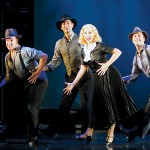“Don’t get me started,” Roger Waters told the crowd at HP Pavilion, not far into his first of two nights performing the classic Pink Floyd album The Wall. “If I start telling jokes, we’ll be here all night.”
Wait, Roger Waters knows jokes? The official Crotchety Old Man of rock, Waters is known for dour expressions, even more dour lyrics, and occasionally suing former band mates to keep them from performing. Oh, and, you know, writing a few of rock’s true masterpiece albums.
“I apologize,” he said. “I’m feeling rather jovial this evening.”
Ah, well then, what a perfect night to recreate his sprawling story of a rock star degenerating into paranoid psychosis, set against a backdrop of war and fascism!
But in fact, it actually was. It’s easy to talk about the awesome power of Waters’ fully operational stage show, but underneath the spectacle of what is certainly the most epic rock concert I’ve ever seen, there was a feeling of liberation radiating from the man at the center of it, which gave the music’s themes of escape from misery and hatred a new power.
That man on stage this week at HP was an entirely different Roger Waters than the one who penned The Wall three decades ago because he himself was feeling the same alienation experienced by its main character, Pink. (Though Pink, it must be noted, was also partially based on Syd Barrett, the mad genius who first led Floyd.)
This was a Roger Waters who smiled while laying out Pink’s deterioration in “One of My Turns,” who tapped his feet during the heartbreakingly sad “Nobody Home” and who waved to the audience while playing rock’s most famous (not to mention best) breakdown anthem, “Comfortably Numb.” When Floyd performed the legendary Wall Tour of 1980 and 1981, Waters was inhabiting the character of Pink—he even wanted to play him in the 1982 film adaptation, until he realized he couldn’t act and allowed Alan Parker to replace him with Bob Geldof.
But this time around, he wasn’t identifying with Pink any longer. This time, he was telling someone else’s story, or perhaps simply a cautionary fantasy. “It’s been a long journey since then, and I don’t feel that way anymore,” he said in a touching moment during the curtain call.
Perhaps that’s why he was able to ask David Gilmour, his estranged former Floyd bandmate, to join him on guitar for the tour. It’s too bad Gilmour wasn’t interested, because he was the only thing missing from this show. The gang of a dozen or so musicians that Waters assembled for this tour (including G.E. Smith on guitar) was excellent, but just as Floyd has never really been able to replace Waters’ conceptual and lyrical genius, no one can bring quite the same heart and soul that Gilmour delivered in his guitar and vocal parts.
Still, Waters has attacked this re-staging with everything’s he got, and it delivers knockout punches all the way through. From the moment an actual scaled-down plane flew across the Pavilion and disappeared into a giant plume of fire, it was obviously useless trying to predict what he would come up with next. The huge pillars of pyrotechnics and the giant puppets were impressive. But it was really what he did with the wall itself that had the most impact.
The idea of building this wall of actual bricks, one by one, until the performers are completely obscured, originated with the original Floyd tour, which ended with a 40-foot wall standing between the band and the audience, which then of course got torn down in the finale. For this tour, Waters built on that idea (no pun intended) to make the ever-evolving wall a blank slate for a series for amazing projections. Sometimes it was graffiti painted with light, another time the lighting was used to make the bottom half of the wall look like a subway car in motion. During the intermission, it served as a shifting gallery of people from around the world killed in battle or political protest. Band members would suddenly appear on top of it, and Waters would sing from perches and spaces in the wall.
At one point, he even sang “Mother” in perfect time with a gigantic projection of himself singing the same song at Earls Court in 1980.
Thirty years later, Waters definitely looks different (though he’s actually in better shape now—he appears to be living the Jack LaLanne Way). But it’s how he feels different that elevated the music and lyrics he wrote for what is probably one of the most depressing albums of all time. His own transformation has finally brought out the hope and redemption Waters built into The Wall.

 Backwards in High Heels
Backwards in High Heels  A New Mosque for San Martin
A New Mosque for San Martin 


